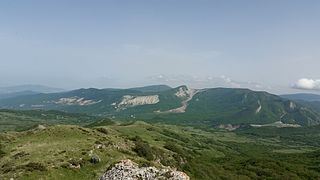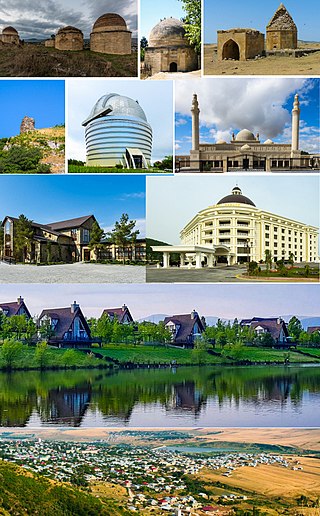
Ujar District is one of the 69 districts of Azerbaijan. It is located in the centre of the country and belongs to the Central Aran Economic Region. The district borders the districts of Agdash, Goychay, Kurdamir, and Zardab. Its capital and largest city is Ujar. As of 2020, the district had a population of 89,500.

Hajigabul District is one of the 69 districts of Azerbaijan. It is located in the east of the country, in the Shirvan-Salyan Economic Region. The district borders the districts of Kurdamir, Agsu, Shamakhi, Gobustan, Absheron, Baku, Salyan, Sabirabad and the city of Shirvan. Its capital and largest city is Hajigabul. As of 2020, the district had a population of 76,600.

Shamakhi District is one of the 69 districts of Azerbaijan. It is located in the east of the country and belongs to the Mountainous Shirvan Economic Region. The district borders the districts of Quba, Khizi, Gobustan, Hajigabul, Agsu, and Ismayilli. Its capital and largest city is Shamakhi. As of 2020, the district had a population of 106,400.

Khizi District is one of the 69 districts of Azerbaijan. Located in the east of the country, it belongs to the Absheron-Khizi Economic Region. The district borders the districts of Siyazan, Shabran, Quba, Shamakhi, Gobustan, and Absheron-Khizi. Its capital and largest city is Khizi. As of 2020, the district had a population of 17,100, making it the least populated district of Azerbaijan.

The Palace of the Shirvanshahs is a 15th-century palace built by the Shirvanshahs and described by UNESCO as "one of the pearls of Azerbaijan's architecture". It is located in the Inner City of Baku, Azerbaijan and, together with the Maiden Tower, forms an ensemble of historic monuments inscribed under the UNESCO World Heritage List of Historical Monuments. The complex contains the main building of the palace, Divanhane, the burial-vaults, the shah's mosque with a minaret, Seyid Yahya Bakuvi's mausoleum, south of the palace, a portal in the east, Murad's gate, a reservoir and the remnants of a bath house. Earlier, there was an ancient mosque, next to the mausoleum. There are still ruins of the bath to the west of the tomb.

Shamakhi is a city in Azerbaijan and the administrative centre of the Shamakhi District. The city's estimated population as of 2010 was 31,704. It is famous for its traditional dancers, the Shamakhi Dancers, and also for perhaps giving its name to the Soumak rugs.
The architecture of Azerbaijan refers to the architecture development in Azerbaijan.

The Shirvanshahs were the rulers of Shirvan from 861 to 1538. The first ruling line were the Yazidids, an originally Arab and later Persianized dynasty, who became known as the Kasranids. The second ruling line were the Darbandi, distant relatives of the Yazidids/Kasranids.

Tourism in Azerbaijan has been an important sector of the Azerbaijani economy since the 1990s. According to Azerbaijan's Center for Economic and Social Development, the country is in 39th place among 148 countries in tourism competitiveness indicators. The World Travel and Tourism Council reported that Azerbaijan is among the top ten countries with the greatest increase in visitor exports from 2010 to 2016. The country had the world's fastest-developing travel and tourism economy in 2017. To promote tourism, Azerbaijan sponsored Atlético Madrid jerseys reading "Azerbaijan – Land of Fire". In 2018, a new tourism brand and a slogan "take another look" were introduced.
Azerbaijani art is the art created by Azerbaijanis. They have created rich and distinctive art, a major part of which is applied art items. This form of art rooted in antiquity, is represented by a wide range of handicrafts, such as chasing (metalworking), jewellery-making, engraving, carving wood, stone and bone, carpet-making, lacing, pattern weaving and printing, and knitting and embroidery. Each of these decorative arts is evidence of the culture and the abilities of the Azerbaijan nation, and are very popular there. Many interesting facts pertaining to the development of arts and crafts in Azerbaijan were reported by merchants, travellers and diplomats who visited these places at different times.

The Tuba-Shahi Mosque is a historical and architectural monument of the 15th century located in the Mardakan village of the Khazar district in Baku (Azerbaijan). The mosque is included in the list of the historical and architectural monuments of local importance approved by the Cabinet of Ministers of the Republic of Azerbaijan. It was built not far from the Quadrangular Mardakan Castle dating back to the era of the Shirvanshahs.

The Shirvan province was a province founded by the Safavid Empire on the territory of modern Azerbaijan and Russia (Dagestan) between 1501 and 1736 with its capital in the town of Shamakhi.

Juma Mosque of Shamakhi or Juma Mosque of Shamakhi is a mosque in the city of Shamakhi, Azerbaijan.

Baku Fortress is a medieval building in Baku, Azerbaijan, the largest of Absheron fortresses. The fortress consists of the Icheri Sheher and the walls and towers surrounding it and it was included by UNESCO into the World Cultural Heritage List in 2000. It was built in about 1138–1139 on the order of the Shirvanshah Manuchohr III (1120–1149).

Pir Mardakan Khanqah is historic architectural monument located in the village of Goylar, 16 km south-west of Shamakhi district of the Azerbaijan Republic. The complex includes a tomb, a dynasty building and small auxiliary buildings. It was built in XIII–XIV centuries. According to some sources, this is the tomb of Seyid Mardakani, one of the famous scholars of his time.
Galeyi Beygurt, also known as Galey-Bughurt or simply Bughurt fortress is a historic monument located 20 km north-east of the center of Shamakhi city.

Shakiragha mausoleum is a historical monument of the XV century. It is located in Balakhany village in the city of Baku in Azerbaijan.
The High Middle Ages, or Classic Feudalism Period in what constitutes the present-day Republic of Azerbaijan, lasted from around the 11th century to the 15th century AD. The High Middle Ages were preceded by the Early Middle Ages and were followed by the Late Middle Ages, which ended around the 15thcentury AD. Key historical trends of the High Middle Ages include the incorporation of the territories that constitute present-day Azerbaijan into the Seljuk Empire, the establishment of the Eldiguzids, the Mongol invasions and the rule of the Ilkhanate, the invasions of Timur and the establishment of the Turkoman Kara Koyunlu and Aq Qoyunlu tribal confederations.

Gulustan Fortress or Castle is a medieval castle dating back to the 9th-12th centuries located in Shamakhi District of Azerbaijan. Although the oldest archeological findings from the castle date back to the 9th century, the Gulustan castle was radically rebuilt and strengthened in the 12th century - the beginning of the 13th century.
















